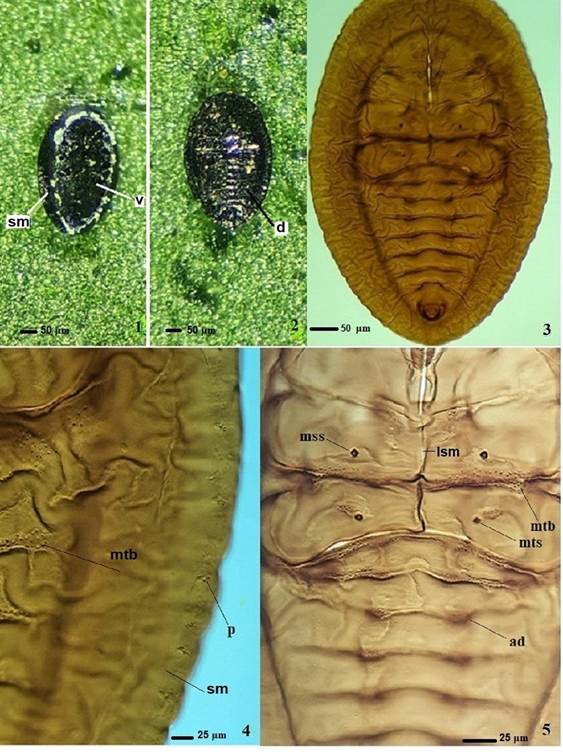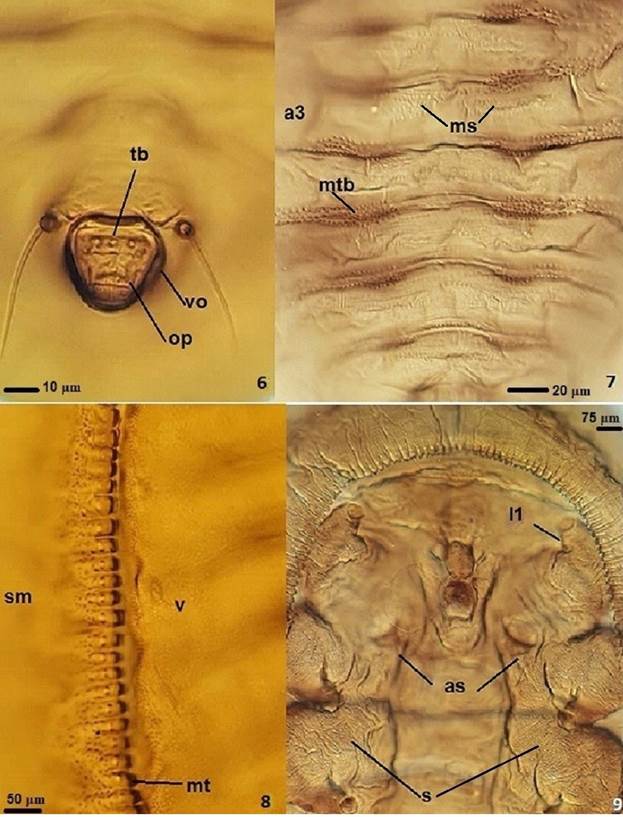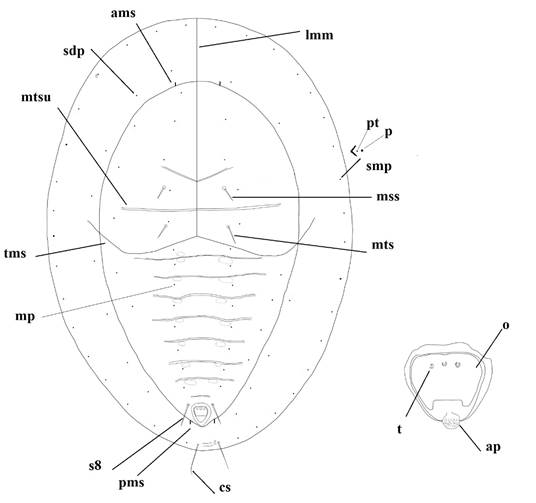Introduction
AleuropleurocelusDrews & Sampson, 1956 is a genus of whiteflies (Aleyrodidae) with 26 described species distributed in the Americas. Taxonomic knowledge of this genus has increased remarkably in recent years with the discovery and description of a large number of new species, primarily from Mexico, Guatemala, and the United States of America (Carapia-Ruiz, 2020a; 2020b; Carapia-Ruiz et al., 2018a; 2018b; 2021; Carapia-Ruiz & Sánchez-Flores, 2019a; 2019b; Sánchez-Flores & Carapia-Ruiz, 2018a; 2018b; Sánchez-Flores et al., 2018a; 2018b; 2020; 2021).
The genus Aleuropleurocelus includes whiteflies mainly with black puparia that have a deflexed submarginal area and toothed margin. A species from Guatemala with characters corresponding to those of this genus, but with specific features different from those on the known species is described and compared with closely related species.
Materials and methods
Aleuropleurocelus whitefly pupae were collected from the underside of leaves of a plant belonging to the genus Acalypha plants (Euphorbiaceae) in Machaquilá, Municipality of Poptún, Department of Petén, Guatemala, on the geographic coordinates 16° 22' 52" N, 89° 29' 21" W, at an approximate elevation of 450 meters. The specimens were transferred for examination to the “Laboratorio de Diagnóstico Fitosanitario”, Ministerio de Agricultura Ganadería y Alimentación, Petén, Guatemala. Initially, they were photographed under a stereoscopic microscope; later, the pupae were mounted on slides following the methodology by Martin (2004). The microscope was a Leica DM 2500 (Leica®) with differential interference contrast. Observations were made at 40, 100, 400, and 1,000 magnifications. Photographs were taken with a Nikon D5300 (Nikon®) camera with an 18-55 mm lens. The description of the new species was mainly based on slide mounted pupas. The terminology is that of Drews and Sampson (1956) and Martin (2005).
Specimens repositories:
UVGC: Colección de Artrópodos, Universidad del Valle de Guatemala. Ciudad de Guatemala, Guatemala.
CNIN: Colección Nacional de Insectos, Instituto de Biología, Universidad Nacional Autónoma de México. Mexico City, Mexico.
JFGO: Personal Collection of José Francisco García-Ochaeta.
OASF: Personal Collection of Oscar Ángel Sánchez-Flores.
VECR: Personal Collection of Vicente Emilio Carapia-Ruiz.
Aleuropleurocelus petenensis sp. nov. Carapia-Ruiz & García-Ochaeta, 2023
http://zoobank.org/urn:lsid:zoobank.org:act:D6BBB1EC-282B-4B84-A081-BC702E358FFA
General form. In situ pupae. Black, usually located on the underside of leaves, with a band of white wax around the body that arises from the teeth of the pupal margin where adhesion to the surface of the leaf begins (Figs. 1, 2).

Figures 1-5 Aleuropleurocelus petenensis sp. nov. 1) Pupa on the leaf of Acalypha sp., ventral view, 2) pupa on the leaf of Acalypha sp., dorsal view, 3) slide-mounted pupa, dorsal view, 4) detail of subdorsal and submarginal area, 5) area of thorax and abdomen. ad= abdominal depression, d= dorsum, lsm= longitudinal suture of the molt, mss= mesothoracic seta, mts= metathoracic seta, mtb= microtubercles, p= pore, sm= submargin, v= venter.
Specimens on slides. Boat-form body, 520 to 620 μm in length, 320 to 410 μm in width (n = 20) (Fig. 3). Submarginal band deflexed (Figs. 3, 8). Margin and submargin . Toothed margin, each tooth about 20 μm in width and 5 μm apart from each other. Tuberculated submargin 70 μm in width, the tubercles more abundant in proximity to marginal teeth (pupal margin) (Figs. 8, 9). Cephaloprothorax . Without ocular marks or cephalic setae. The cephalic area and prothorax 235 μm in length, not clearly differentiated; pro-mesothoracic suture well-defined, with tubercles in the mesothoracic area near the longitudinal suture of the molt; mesothorax 50 μm in length along the midline, with well-defined meso-metathoracic suture, with adjacent tubercles on metathorax and mesothorax; metathorax 35 μm in length along midline (Figs. 3, 5). Thorax with two pairs of setae, mesothoracic setae 18 μm long and metathoracic setae 20 μm long, with a tuberculated area anterolateral to the metathoracic setae (Fig. 5 and 11). Longitudinal suture of the molt approximately 305 μm long, without tubercles (Fig. 5); transverse suture of the molt 240 μm long, without tubercles, curved posteriorly from middle of the suture to level of subdorsum, then curved anteriorly, not reaching meso-metathoracic suture, and ending before the submarginal line (Fig. 11). Subdorsal area near the submarginal line (apparent margin) with a regular row of pores and poretes, with irregular folds or reliefs on subdorsal surface of the pupa (Fig. 4). Abdomen. Dorsum of abdominal segments I-VIII clearly visible in the middle part, with approximate length for each segment as follow: I - 24 μm, II - 26 μm, III - 28 μm, IV - 28 μm, V - 28 μm, VI - 30 μm, VII - 24 μm (well-developed), and VIII (from suture VII-VIII to vasiform orifice) - 38 μm. Abdominal segments with a pair of depressions in the submedian area, with small tubercles; length of the transverse band of tubercles on each segment as follow: I - 77 μm, II - 57 μm, III - 75 μm, IV - 80 μm, V - 65 μm, VI - 55 μm, and VII - 35 μm; submedian area of the abdominal segments between depressions without tubercles. The submedian area of the abdominal segments with transverse rows of elongated microstructures (Figs. 5, 7). Vasiform orifice. Semi-oval, 30 μm in length and 31 μm in width. Operculum length of 28 μm, width of 27 μm, with three tubercles in the anterior part, giving it a characteristic sculpted form, completely covering the spatulate lingula and most of the vasiform orifice; ring of vasiform orifice not well-defined, with elevation at its posterior part; abdominal setae VIII anterolateral to the anterior margin of the orifice, clearly differentiated in mounted specimens (Fig. 6). Distance from the posterior margin of the vasiform orifice to the submarginal line 44 μm, well-defined caudal protuberance (Fig. 3). Venter. Antennae length 52 μm, extending posteriorly. Prothoracic legs 88-91 μm long, mesothoracic legs 78-82 μm long, metathoracic legs 70-72 μm long; adhesive sacs of the legs 12 μm in diameter; surface of the legs with spinules (Fig. 10), similar to the contiguous ventral surface. A pair of adhesive sacs 18-24 μm in diameter and 16 μm in length, located between the base of the first pair of legs (Fig. 9); posterior abdominal setae 15 μm long; the posterior spiracles between a sclerotized structure. Pores. Dorsum of the pupa with a row of approximately 17 to 18 pairs of associated pores and poretes near the submarginal fold (Fig. 4 and 11), 16 to 18 pairs in the subdorsal region, and 14 pairs in the submedian area of the puparium (Fig. 11). Chaetotaxy. Dorsum without cephalic setae; a pair of mesothoracic setae 18 μm long, a metathoracic pair 20 μm long, and a pair on abdominal segment VIII 62 μm long, each derived from a tuberculated base; two caudal setae near the posterior margin 100 μm long; anterior and posterior marginal setae present 9-10 μm in length (Fig. 11).

Figures 6-9 Aleuropleurocelus petenensis sp. nov. 6) Vasiform orifice, 7) dorsal surface abdomen, 8) submarginal band and marginal teeth, 9) spinules on the base of legs. A3= abdominal segment 3, as= abdominal sac, l1= foreleg, mt= marginal teeth, ms= microstructures, mtb= microtubercles, op= operculum, s= spinules, sm= submargin, tb= tubercles, vo= vasiform orifice, v= venter.

Figure 10 Aleuropleurocelus petenensis sp. nov. Submargin and venter. as= abdominal sac, l1= foreleg, l2= midleg, l3= hindleg, mt= marginal teeth, s= spinules, sm= submargin, v= venter.

Figure 11 Structures of Aleuropleurocelus petenensis sp. nov. ap= apical area of the operculum, cs= caudal seta, lmm= longitudinal suture of the molt, mp= submedian pore, mss= mesothoracic seta, mts= metathoracic seta, mtsu= metathoracic suture, o= operculum, p= pore, pt= porete, tms= transverse suture of the molt, s8= abdominal seta 8, sdp= subdorsal pore, smp= submarginal pore, t= tubercle, vo= vasiform orifice.
Type material. Holotype: Guatemala, Petén, Poptún, Machaquilá, 16° 22' 52" N, 89° 29' 21" W, elevation 450 m, collected from Acalypha sp. leaves, 2-viii-2021. Deposited in the UVGC collection. Paratypes: 24 with the same data as holotype. Two specimens in UVGC, 2 in CNIN, 5 in VECR, 5 in OASF, and 10 in JFGO.
Etymology. The specific epithet petenensis is in reference to the Petén region, in northern Guatemala, where these specimens were collected.
Hosts. Acalypha sp. (Euphorbiaceae).
Distribution. Petén, Guatemala.
Discussion
Aleuropleurocelus petenensis sp. nov. is a species in the group characterized by the boat-shaped form, which have the termination of the transverse suture of the molt anterior to the submarginal line. The new species differs from A. palidonigrans Carapia-Ruiz & Sánchez-Flores, A. nigrans (Bemis), A. pallidus Carapia-Ruiz & Sánchez-Flores, and A. mixtecus Carapia-Ruiz in the presence of black coloration on the venter, while in the other species the venter is pale. The above proves that the color of the venter is an important character for the differentiation of certain species as reported by Carapia-Ruiz (2020b). Aleuropleurocelus pallidus Carapia-Ruiz & Sánchez-Flores has capitate marginal teeth and the new species has truncated marginal teeth. Aleuropleurocelus mixtecus Carapia-Ruiz is one of the species most closely related to A. petenensis but the new species has a tuberculated areas on the dorsal surface.











 nueva página del texto (beta)
nueva página del texto (beta)



